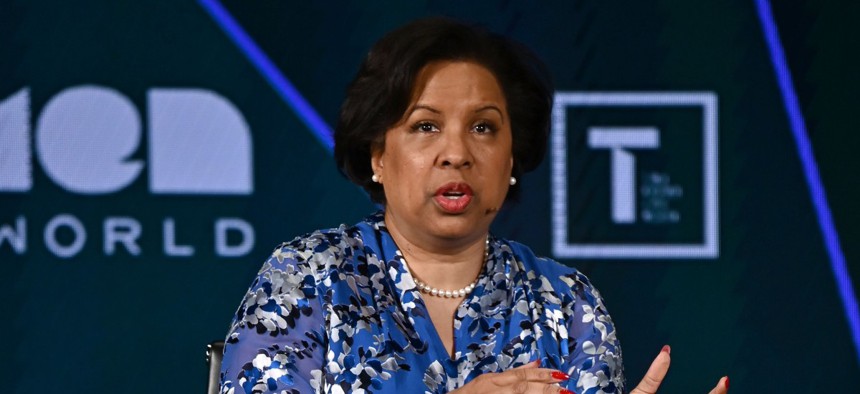SAIC shows part of its investment hand

Toni Townes-Whitley speaks onstage at the 10th Anniversary Women In The World Summit - Day 2 at David H. Koch Theater at Lincoln Center on April 11, 2019 in New York City. Photo by Mike Coppola / Getty Images
In her most recent talk with Wall Street, CEO Toni Townes-Whitley describes the "three flavors of investment" that Science Applications International Corp. is prioritizing.
Toni Townes-Whitley has spent her first five months as chief executive of Science Applications International Corp. on what she once called "forming and testing certain hypotheses" to help create the next iteration of SAIC's strategy.
During SAIC's fiscal fourth quarter and year-end earnings call Monday, Townes-Whitley described to investors what she has found so far and the moves SAIC has made since then on the corporate strategy front.
One word of caution is in order to start out with. SAIC is holding an investor day on April 11, during which Townes-Whitley and other senior executives will more fully unveil the long-term strategy and outlook over a three-to-four hour event.
Which means much more is to come on the level of detail front. But on the Monday call with analysts, Townes-Whitley identified "three flavors of investment" that SAIC is making in itself to attain more consistent organic growth.
SAIC is putting roughly $15 million into its cloud-based innovation factory that is geared toward the company's work in areas like artificial intelligence, secure data, digital engineering, and of course cloud computing itself.
"The investments we're making are primarily in people, but also tools and some capabilities that we are looking to expand to ensure that those differentiators when systematically deployed across all our programs can be integrated into our customer environments," Townes-Whitley said.
Area number two for investment is in business development, which is the engine that drives organic growth in the government technology and services market.
Townes-Whitley acknowledged that SAIC has challenges in its current posture of keeping its recompete contracts and in the quality of its strategic bids for new business. She told analysts that this area is also one of talent-focused investment, but more resources are going toward business development as well.
SAIC also is focusing on "what we call capture and solution architecting, which is all around ensuring that we create more value for our customers in existing programs and that we can bid in a systematic standardized way with higher talent and greater talent in certain areas," Townes-Whitley added.
Upskilling is SAIC's third major area of investment, through which the company is seeking to help its customer-facing employees evolve their career as the technologies and delivery models do.
Throughout the call, and likely something to expect on the investor day, is Townes-Whitley's use of the word "systematic" and variations of it to describe how SAIC is looking to approach this new iteration of its vision and strategy.
"One area that we've got to make sure is that our solution differentiation is not only clear, but also well presented in the proposals and is systematically part of all things that we bid across our factory," Townes-Whitley said. "The second area is making sure that our processes are standard, and that means that how we run bid and capture has to be systematic (and) standardized in the DNA, no compromise approach at the enterprise level, which is why I centralized and put under one human, quite frankly, and with direct reporting into the executive team."
Fiscal fourth quarter revenue of $1.7 billion was down approximately 11.7% from the prior year period, primarily on SAIC's sale of the supply chain business to ASRC Federal and deconsolidation of the Forfeiture Support Associates joint venture co-held with Amentum. After adjusting for those transactions, sales increased by approximately 7.7%.
Full fiscal year 2024 revenue of $7.4 billion was down 3.9% from the sales for FY 2023, also primarily on the transactions involving ASRC Federal and FSA. After adjusting for those transactions, the sales growth figure becomes approximately 7.4%.
Profit in the quarter of $127 million represented a 26.2% year-over-year decline in adjusted EBITDA (earnings before interest, taxes, depreciation and amortization. Adjusted EBITDA of $680 million for the full FY 2024 was lower by 1.7% compared to the FY 2023 bottom line.
SAIC's initial guidance for its 2025 fiscal year started Feb. 1 has revenue in the range of $7.35 billion-to-$7.5 billion on adjusted EBITDA of $680 million-to-$700 million, which suggests an adjusted EBITDA margin of 9.2%-to-9.4%.


